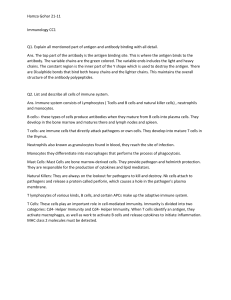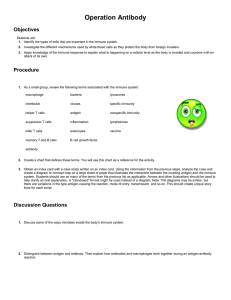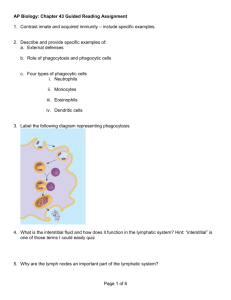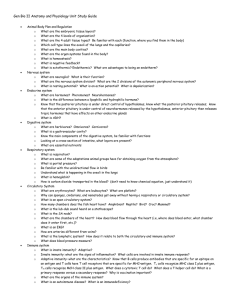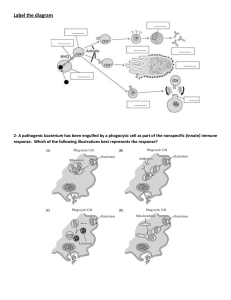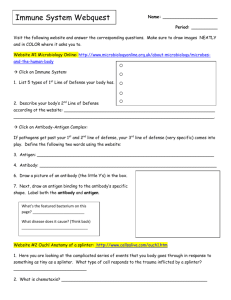Kuby Immunology 6/e
advertisement
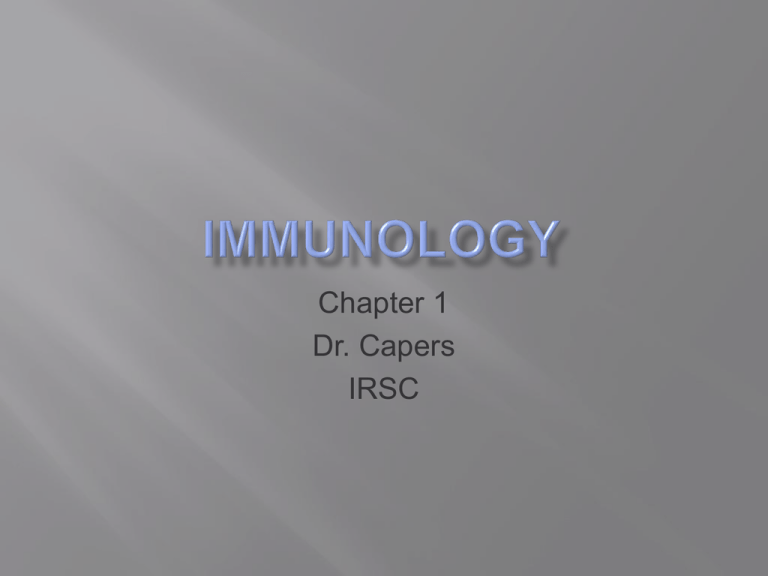
Chapter 1 Dr. Capers IRSC Kindt • Goldsby • Osborne Kuby IMMUNOLOGY Sixth Edition Chapter 1 Overview of the Immune System Copyright © 2007 by W. H. Freeman and Company Discipline of immunology grew out of observation that individuals who recovered from infectious diseases were protected from disease 15th Century Chinese and Turks tried to prevent smallpox Dried crust from pustules were inhaled or inserted into small cuts 1718 Lady Montagu had that technique done in her children 1798 Edward Jenner Noticed that milkmaids that contracted cowpox were immune to smallpox Innoculated small boy with fluid from cowpox pustule He then intentionally infected the boy with smallpox – the child did not develop smallpox 1881 Louis Pasteur Vaccinated sheep with heat-attenuated anthrax Then infected sheep with virulent strain of anthrax – they did not develop anthrax 1977 Last known naturally acquired case of smallpox Is it still a threat? In industrialized nations, measles, mumps, whooping cough, tetanus, polio, and diptheria are extremely rare or nonexistent This is due to vaccines! Prevent death, paralysis, deafness, blindness, mental retardation 1883 Metchnikoff demonstrated that certain white blood cells were able to phagocytize microorganisms 1901 Von Behring and Kitasato Demonstrated that serum (noncellular component of blood) from animals immunized to diptheria could transfer that immunity to non-immunized animals Immune system evolved to protect multicellular organisms from pathogens Does this by 2 related activites Recognition and response Innate Immunity 1st line of defense Molecular and cellular mechanisms deployed before an infection Distinguishes between self and pathogens but not specialized to distinguish small differences in the foreign particles Adaptive Immunity Develops in response to infection Adapts to recognize, eliminate, and remember pathogen Less specific 1st line of defense Barriers that protect host Skin Acidity of stomach Lysozymes in fluids Phagocytic cells Antimicrobial peptides (interferons, complement) Temperature Highly specific Characteristic attributes Antigenic specificity Antibodies can distinguish between 2 proteins that differ in only 1 amino acid Diversity Immunologic memory Self-nonself recognition Effective Immune response involves 2 groups of cells Lymphocytes B cells T cells Antigen-presenting cells B cells Mature in bone marrow Antigen binding receptor – Antibody Glycoproteins Glycoproteins Structure 2 identical polypeptides – heavy chains 2 shorter identical polypeptides – light chains Antigen coated by antibody is eliminated in several ways Antibody can cross-link several antigens, making it easier to be ingested by phagocytic cells Activate complement system resulting in lysis of microorganism T cells Arise in bone marrow but mature in thymus 2 well define subpopulations of T cells T helper cells T cytotoxic cells T cells Can only recognize antigen bound to cell membrane proteins called Major Histocompatibility Complex (MHC) MHC molecules are expressed by antigenpresenting cells B cells Macrophages Dendritic cells T cells Cytokines secreted by TH cells can activate phagocytic cells TC cells can kill altered self-cells Cells infected by viruses Tumor cells Antigen presenting cell associating with T cell Initial encounter with antigen causes primary response Later contact with antigen will result in more rapid response Allergies and Asthma Graft rejection Autoimmune Disease Immunodeficiency
